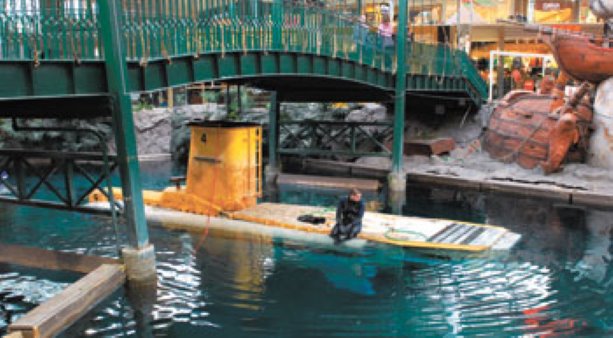The underwater construction crews at North Vancouver-based All-Sea Enterprises Ltd. do not do a lot of work in Alberta — let alone dismantle a fleet of four aging submarines. Then again, their client list doesn’t generally include the West Edmonton Mall.
The four submarines once plied Deep Sea Adventure Lake, the world’s largest indoor lake, which was constructed in 1985.
The submarines took up to 24 passengers at a time on a 20- to 30-minute tour of the lake, where they could view a simulated treasure ship and coral reefs in addition to actual sea life, housed in aquariums along the predetermined route.
The popularity of the ride dwindled through the late 1990s and when a buyer for the attraction couldn’t be found, the fleet was mothballed after its final voyage in 2005. Parked in the lake, their condition continued to deteriorate.
All-Sea was called in with a crew of five, which arrived by plane to demolish the fleet. The company specializes in underwater ship repairs, underwater oil and gas inspections and repairs, and underwater construction and welding.
Matt Bone, senior surface engineer with All-Sea, says the company was called in not only because of its impeccable safety record and expertise, but also because of its unique arsenal of tools.
“The tools we used are purpose-built hydraulic saws which we developed ourselves to handle underwater construction and demolition work,” he says.
“They couldn’t drain the water from the lake in this case, because they needed to maintain the hydraulic pressure on the faces of the aquariums located inside the lake.”
Work on the project began on March 19th with a televised press conference.
The subs, with designs based on the U.S. Navy’s 1950s Polaris models, were dismantled one at a time, with each sub taking about a week to process.
The crew first parked each vessel at the north side of the lake near the popular Deep Sea Derby bumper boat attraction, which was temporarily shut down during the demolition project. Once in place, the vessels could be floated, allowing workers to gut the insides.
“We had to move them by hand because their batteries had died long ago,” says Bone.
“Once they were raised we had easy access to the interior. Once they were gutted and emptied, they could be moved back to the docking area at the east end of the lake and submerged.”
The crew then brought in the hydraulic saws and cut the submarines into one-tonne chunks that could be lifted out of the water by crane.
Underwater workers performed their duties wearing wet suits and dry suits in three-hour shifts, diving about 14 feet to access the bottom of each vessel. Most of the underwater work was completed during shopping hours in full view of customers, while the crane operations were limited to nighttime hours after stores and attractions had closed.
Each submarine weighed about 38 tonnes, with the hull made largely of eight tonnes of aluminum and the bottom made of 30 tonnes of lead to provide ballast for the boats as they carried passengers.
Bone says the work is among the pleasantest projects his crew has ever taken on.
“They’re used to working in remote locations like the Arctic,” he says. “The water here isn’t cold and isn’t moving, and it’s a rare treat for them to take a break and walk over to the coffee shop for a latte.”
Work on the project was expected to conclude the third week of April.



Recent Comments
comments for this post are closed